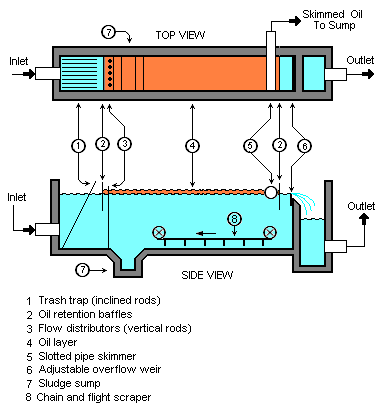API oil–water separator
An API oil–water separator is a device designed to separate gross amounts of oil and suspended solids from the wastewater effluents of oil refineries, petrochemical plants, chemical plants, natural gas processing plants and other industrial oily water sources. The name is derived from the fact that such separators are designed according to standards published by the American Petroleum Institute (API).[1][2]
Description of the design and operation

The API separator is a gravity separation device designed using Stokes' law principles that define the rise velocity of oil droplets based on their density, size and water properties. The design of the separator is based on the specific gravity difference between the oil and the wastewater because that difference is much smaller than the specific gravity difference between the suspended solids and water. Based on that design criterion, most of the suspended solids will settle to the bottom of the separator as a sediment layer, the oil will rise to top of the separator, and the wastewater will be the middle layer between the oil on top and the solids on the bottom.[2] The API Design Standards, when correctly applied, make adjustments to the geometry, design and size of the separator beyond simple Stokes Law principles. This includes allowances for water flow entrance and exit turbulence losses as well as other factors.
Typically in operation of API separators the oil layer, which may contain en-trained water and attached suspended solids, is continually skimmed off. This removed oily layer may be re-processing to recover valuable products, or disposed of. The heavier bottom sediment layer is removed by a chain and flight scraper (or similar device) and a sludge pump.
Design Limitations
API design separators, and similar gravity tanks, are not intended to be effective when any of the following conditions apply to the feed conditions:
- Mean Oil droplets size in the feed is less than 150 micron
- Oil density is greater than 925 kg/m3
- Suspended solids are adhering to the oil meaning the 'effective' oil density is greater than 925 kg/m3
- Water temperature less than 5 oC
- There are high levels of dissolved hydrocarbons
Further Treatment of API water discharges
Because of performance limitations the water discharged from API type separators usually requires several further processing stages before the treated water can be discharged or reused. Further water treatment is designed to remove oil droplets smaller than 150 micron, dissolved materials and hydrocarbons, heavier oils or other contaminants not removed by the API. Secondary treatment technologies include dissolved air flotation (DAF), Anaerobic and Aerobic biological treatment, Parallel Plate Sseparators, Hydrocyclone, Walnut Shell Filters and Media filters.
Plate separators, or Coalescing Plate Separators are similar to API separators, in that they are based on Stokes Law principles, but include inclined plate assemblies (also known as parallel packs).[2] The underside of each parallel plate provides more surface for suspended oil droplets to coalesce into larger globules. Coalescing plate separators may not be effective in situation where water chemicals or suspended solids restrict or prevent oil droplets coalesce. In operation it is intended that sediment will slide down the topside of each parallel plate, however in many practical situations the sediment can adhere to the plates requiring periodic removal and cleaning. Such separators still depend upon the specific gravity between the suspended oil and the water. However, the parallel plates can enhance the degree of oil-water separation for oil droplets above 50 micron in size. Alternatively parallel plate separators are added to the design of API Separators and require less space than a conventional API separator to achieve a similar degree of separation.

History
The API separator was developed by the API and the Rex Chain Belt Company (now Siemens Water). The first API separator was installed in 1933 at the Atlantic Refining Company (ARCO) refinery in Philadelphia. Since that time, virtually all of the refineries worldwide have installed API separators as a first primary stage of their oily wastewater treatment plants. The majority of those refineries installed the API separators using the original design based on the specific gravity difference between oil and water. However, many refineries now use plastic parallel plate packing to enhance the gravity separation.[1][2]
Other oil–water separation applications
There are other applications requiring oil-water separation. For example:
- Oily water separators (OWS) for separating oil from the bilge water accumulated in ships as required by the international MARPOL Convention.[3][4]
- Oil and water separators are commonly used in electrical substations. The transformers found in substations use a large amount of oil for cooling purposes. Moats are constructed surrounding unenclosed substations to catch any leaked oil, but these will also catch rainwater. Oil and water separators therefore provide a quicker and easier cleanup of an oil leak.[5]
See also
- Pollution
- Wastewater
- Industrial wastewater treatment
- Industrial water treatment
- Centrifugal oil–water separator
References
- 1 2 American Petroleum Institute (API) (February 1990). Management of Water Discharges: Design and Operations of Oil-Water Separators (1st ed.). American Petroleum Institute.
- 1 2 3 4 Beychok, Milton R. (1967). Aqueous Wastes from Petroleum and Petrochemical Plants (1st ed.). John Wiley & Sons. LCCN 67019834.
- ↑ International Convention for the Prevention of Pollution from Ships, 1973 (and later amendments) Archived March 31, 2008, at the Wayback Machine.
- ↑ Oily water separator
- ↑ Leonard L.Grigsby (2001). The Electrical Power Engineering Handbook. CRC Press. ISBN 0-8493-8578-4.
External links
- Photographs, drawings and design discussion of gravimetric API Separators
- Oil/Water Separators Diagrams and description of separators using plastic parallel plate packing.
- Oil-in-water Separation Good discussion and explanation of wastewater treatment processes.
- Monroe Environmental API Separators Manufacturer, drawings, photographs, diagrams, case studies, and descriptions.
- Oil Water Separators Features, Case Studies, Technology, Photos
